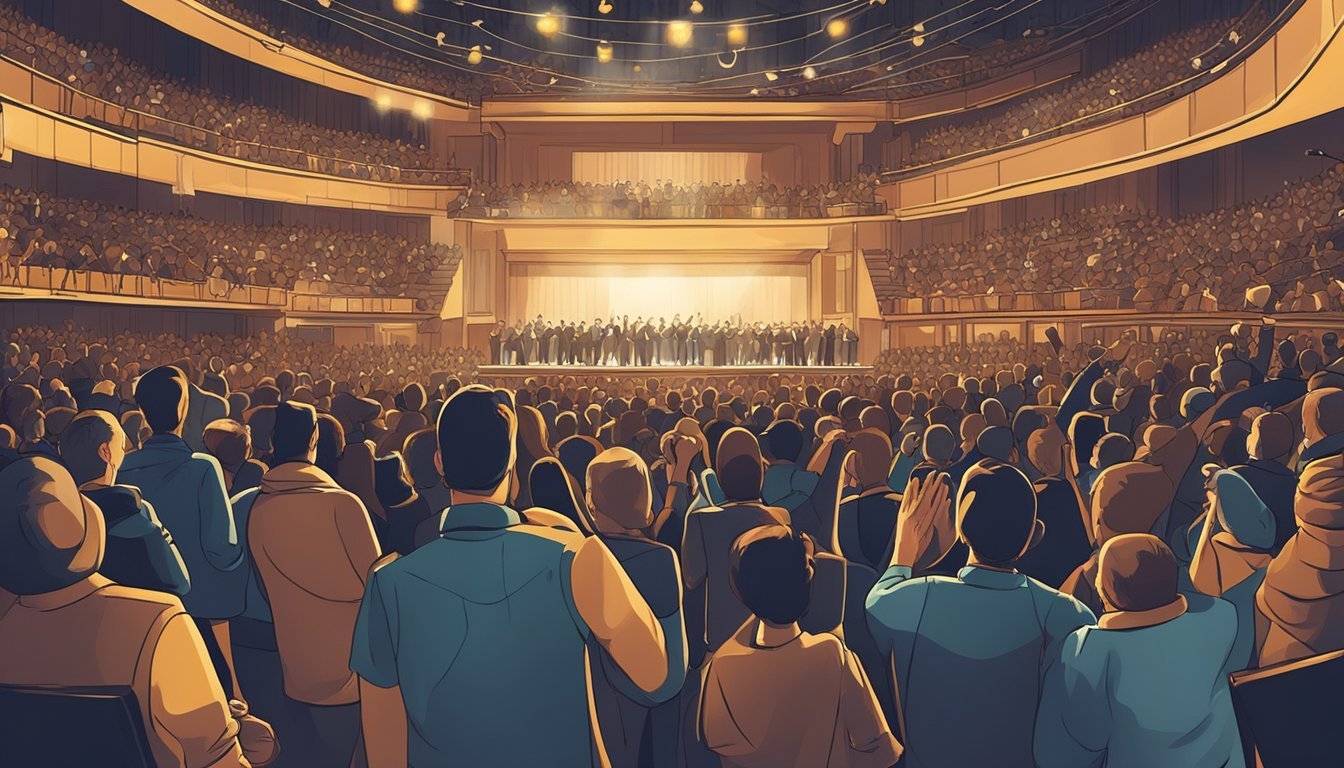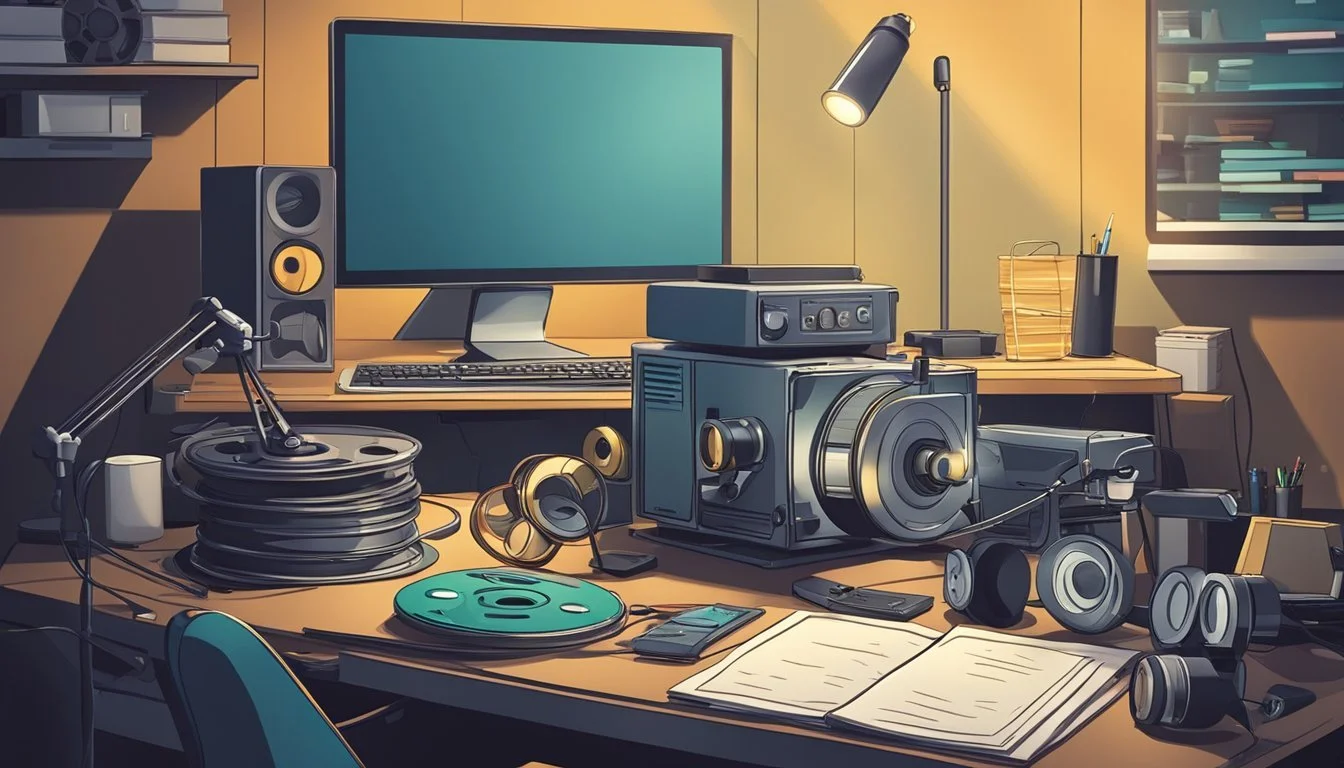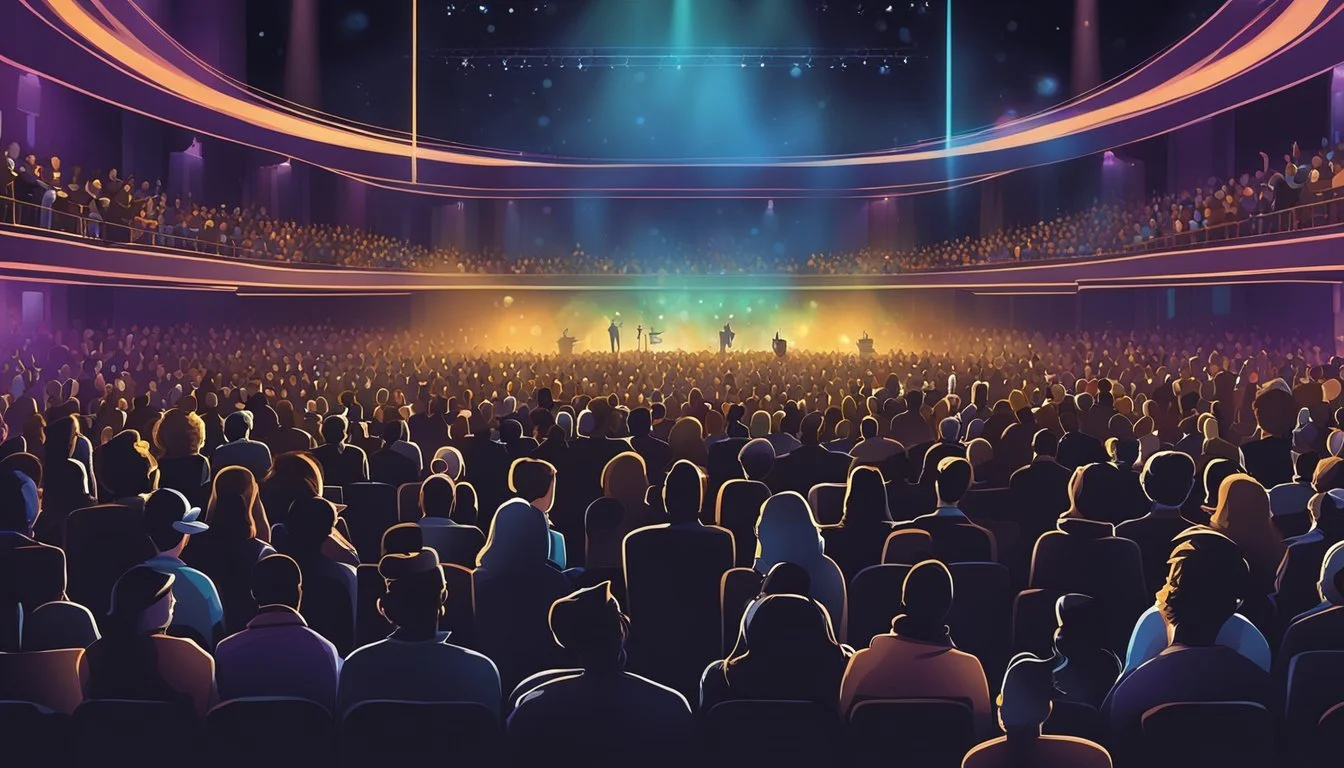Rock's Greatest Farewell: The Last Waltz Docu Reveals Untold Secrets and Stardom
The Last Waltz stands as a landmark documentary capturing The Band's farewell concert on Thanksgiving Day 1976. Directed by Martin Scorsese, this film immortalizes the Canadian-American rock group's final performance at San Francisco's Winterland Ballroom.
The Last Waltz transcends typical concert films by blending live performances with candid interviews and behind-the-scenes footage. Scorsese's masterful direction elevates the documentary, offering viewers an intimate glimpse into The Band's musical journey and the end of an era in rock history.
The film features an impressive lineup of guest performers, including Bob Dylan, Eric Clapton, and Neil Young. These collaborations showcase The Band's far-reaching influence and the respect they commanded within the music industry. The Last Waltz remains a seminal work, preserving a pivotal moment in rock music for future generations to experience and appreciate.
Background and Development
The Last Waltz documentary emerged from a unique confluence of musical talent, cinematic vision, and rock history. Its creation involved careful planning and collaboration between The Band and director Martin Scorsese.
Conception of the Film
The idea for The Last Waltz originated with Robbie Robertson, The Band's guitarist and principal songwriter. After years of touring, Robertson felt the group needed a grand finale. He envisioned a concert film that would capture The Band's legacy and showcase their musical connections.
Jonathan Taplin, The Band's tour manager and a film producer, played a crucial role in bringing the concept to life. He connected Robertson with Martin Scorsese, recognizing the director's passion for music and innovative filmmaking style.
The concert was planned for Thanksgiving Day 1976 at San Francisco's Winterland Ballroom, where The Band had played their first show as a headlining act.
Involvement of Martin Scorsese
Martin Scorsese's participation elevated The Last Waltz from a simple concert recording to a cinematic event. The director brought his keen eye for visual storytelling and deep appreciation for rock music to the project.
Scorsese worked closely with Robertson to plan the film's structure and visual style. They chose to intersperse concert footage with interviews and staged performances, creating a multi-layered portrait of The Band and their musical journey.
The director assembled a team of top cinematographers, including Michael Chapman and Vilmos Zsigmond, to capture the concert's energy and intimacy. Scorsese's meticulous approach extended to lighting design and camera placement, ensuring the film would stand out visually among concert documentaries.
The Band's Place in Rock History
The Last Waltz served as a testament to The Band's significant influence on rock music. Formed in the early 1960s, the group gained prominence as Bob Dylan's backing band before establishing their own identity.
The Band's unique blend of rock, folk, and Americana helped shape the roots rock genre. Their musicianship and storytelling lyrics set them apart in an era of psychedelic experimentation.
By 1976, The Band had released several acclaimed albums and become respected figures in the rock world. The Last Waltz aimed to celebrate this legacy, featuring guest appearances from musical luminaries who had been influenced by or collaborated with the group.
Filming Details
The Last Waltz documentary captured The Band's farewell concert with meticulous planning and cinematic artistry. Innovative techniques and a star-studded lineup created an iconic concert film.
Winterland Ballroom Venue
The Band's final performance took place at Winterland Ballroom in San Francisco on Thanksgiving Day, 1976. This historic venue provided an intimate setting for the concert. Its capacity of around 5,400 allowed for an energetic crowd while maintaining a close connection between performers and audience.
The stage was transformed for the event. Elaborate set pieces, including chandeliers and props from the San Francisco Opera, created a lavish atmosphere. This design choice elevated the concert beyond a typical rock show, reflecting The Band's musical legacy.
Direction by Scorsese
Martin Scorsese brought his cinematic vision to The Last Waltz. He approached the project as more than just a concert recording. Scorsese's direction focused on capturing the emotion and energy of the performances.
He worked closely with The Band to plan camera angles and movements. This collaboration ensured that key musical moments were highlighted effectively. Scorsese's use of close-ups and reaction shots added depth to the film, showcasing the musicians' interactions and the audience's response.
The director also conducted interviews with band members. These segments provided context and personal insights, enriching the documentary's narrative.
Cinematography and Production Design
Michael Chapman served as the lead cinematographer for The Last Waltz. His expertise in low-light filming was crucial for capturing the concert's ambiance. Chapman used multiple camera setups to provide diverse angles and perspectives.
The production team employed innovative techniques for the time. They used 35mm film, which was unusual for concert recordings. This choice resulted in superior image quality compared to typical music documentaries of the era.
Production designer Boris Leven created a visually striking set. His work complemented the music and enhanced the film's aesthetic appeal. The use of burgundy drapes and ornate decorations transformed Winterland into a grand ballroom.
Careful lighting design highlighted performers and created dramatic effects. This attention to visual detail elevated The Last Waltz from a simple concert film to a cinematic experience.
The Concert Experience
The Last Waltz concert featured an impressive lineup of performances, collaborations with legendary guest artists, and a bittersweet farewell atmosphere. The Band's final show showcased their musical prowess and lasting influence on rock music.
Setlist and Performances
The Band performed many of their classic hits during The Last Waltz concert. Songs like "The Weight," "Up on Cripple Creek," and "The Night They Drove Old Dixie Down" highlighted their unique sound and storytelling abilities.
The setlist blended rock, folk, and Americana influences. Robbie Robertson's guitar work and Levon Helm's distinctive vocals were on full display throughout the night.
The group's tight musicianship and chemistry, honed over years of touring, shone through in their live renditions. Extended jams and solos allowed each member to showcase their instrumental talents.
Guest Artists Collaborations
The Last Waltz featured an all-star roster of guest performers joining The Band on stage. Rock icons like Eric Clapton, Bob Dylan, and Neil Young made memorable appearances.
Van Morrison delivered an energetic performance of "Caravan." Blues legend Muddy Waters electrified the crowd with "Mannish Boy." Neil Diamond and Dr. John added their distinctive styles to the mix.
These collaborations created unique musical moments, blending The Band's rootsy sound with each guest's individual artistry. The variety of performers highlighted The Band's wide-ranging influence across genres.
Farewell Concert Atmosphere
A bittersweet mood permeated The Last Waltz as The Band's final concert. Fans packed San Francisco's Winterland Ballroom, aware they were witnessing the end of an era.
The elaborate stage design, featuring chandeliers and arched scenery, added a touch of elegance to the proceedings. Between songs, band members shared stories and reflected on their musical journey.
As the night progressed, the celebratory spirit grew. The final encore of "I Shall Be Released," featuring all the guest artists, provided a fitting emotional climax to The Band's live farewell.
Post-Production
The post-production phase of "The Last Waltz" spanned 18 months, involving extensive editing, music supervision, and strategic release planning. This period transformed the raw concert footage into a groundbreaking documentary that redefined the genre.
Editing Process
Martin Scorsese meticulously crafted the film's narrative structure during editing. He seamlessly blended concert performances with backstage interviews and studio recordings. The director focused on capturing the essence of The Band's farewell concert while weaving in their musical journey.
Scorsese worked closely with editor Jan Roblee to select the best shots from multiple cameras. They aimed to create a dynamic visual experience that matched the energy of the live performances. The editing process also involved carefully timing cuts to match the rhythm of the music.
Soundtrack and Music Supervision
Robbie Robertson, The Band's guitarist, played a crucial role in supervising the film's soundtrack. He worked with audio engineers to enhance the concert recordings, ensuring optimal sound quality for each performance.
The team faced challenges in balancing the live audio with studio overdubs. Some tracks required additional work to meet the high standards set for the film's release. Robertson collaborated closely with Scorsese to ensure the music aligned perfectly with the visuals.
The soundtrack album, released alongside the film, underwent meticulous mixing and mastering. It featured selected performances from the concert and became a critically acclaimed record in its own right.
Release Strategies
United Artists planned a strategic release for "The Last Waltz" to maximize its impact. The film premiered at the New York Film Festival in April 1978, generating buzz among critics and music enthusiasts.
A limited theatrical release followed, targeting major cities with strong music scenes. This approach helped build word-of-mouth momentum and critical acclaim. The studio also organized special screenings for industry insiders and music journalists to further promote the film.
The simultaneous release of the soundtrack album created a multi-platform marketing opportunity. Radio stations played tracks from the album, indirectly promoting the film. This synergy between the film and soundtrack helped "The Last Waltz" reach a wider audience and solidify its place in music documentary history.
Cultural Impact
The Last Waltz transformed concert films and left an indelible mark on music documentaries. It captured a pivotal moment in rock history while elevating the genre to new artistic heights.
Critical Reception
The Last Waltz received widespread acclaim upon release. Critics praised Scorsese's innovative cinematography and the film's intimate portrayal of The Band. Roger Ebert called it "one of the most important cultural events of the 1970s."
Music journalists lauded the documentary's ability to capture the energy and emotion of live performance. The film's mix of concert footage and backstage interviews provided unique insights into The Band's creative process and interpersonal dynamics.
Some critics noted the absence of certain Band members in interviews, suggesting a potentially incomplete narrative. Despite this, The Last Waltz remains highly regarded for its technical achievements and cultural significance.
Influence on Future Concert Films
The Last Waltz set a new standard for concert documentaries. Its use of multiple cameras, careful lighting, and rehearsed camera movements influenced countless music films that followed.
Scorsese's approach of blending performance footage with interviews and behind-the-scenes moments became a template for rock documentaries. Films like Stop Making Sense and Shine a Light drew inspiration from The Last Waltz's cinematic style.
The documentary's emphasis on storytelling and context, rather than just capturing a performance, changed how filmmakers approached music documentaries. It demonstrated that concert films could be works of art in their own right.
The Legacy of The Last Waltz
The Last Waltz preserves a crucial moment in rock history. It captures The Band at the height of their powers, showcasing their blend of rock, folk, blues, and Americana.
The film's guest performances, featuring icons like Bob Dylan, Neil Young, and Joni Mitchell, provide a snapshot of 1970s popular music. These collaborations highlight The Band's influence and connections within the music industry.
The Last Waltz continues to inspire new generations of musicians and filmmakers. Its enduring popularity has led to multiple re-releases and restorations, ensuring its place in the canon of great music documentaries.
The film's Thanksgiving setting has made it a holiday viewing tradition for many music fans, further cementing its cultural significance.
Distribution and Accessibility
"The Last Waltz" has been widely distributed since its initial release, reaching audiences through various channels and formats over the years. The film's availability has expanded significantly, allowing fans to experience this iconic concert documentary in multiple ways.
Theatrical Release and Box Office Performance
"The Last Waltz" premiered in theaters on April 26, 1978. The film's initial release was met with critical acclaim and moderate commercial success. It played in select theaters across North America, attracting both music enthusiasts and film buffs. While exact box office figures are not widely reported, the documentary's theatrical run helped establish its reputation as a landmark concert film.
The movie's theatrical distribution was relatively limited compared to mainstream releases, focusing primarily on art house cinemas and specialized venues. This targeted approach allowed "The Last Waltz" to find its core audience and build word-of-mouth buzz.
Availability on Streaming Platforms
In recent years, "The Last Waltz" has become readily accessible on various streaming platforms. The film is available for rental or purchase on Prime Video, offering viewers the convenience of watching from home. It can also be streamed for free on Tubi, with advertisements.
Other streaming services occasionally feature the documentary in their rotating catalogs. This widespread digital availability has introduced the film to new generations of viewers and allowed long-time fans to revisit the concert experience easily.
Home Video and Special Editions
"The Last Waltz" has been released in multiple home video formats over the years. The film received a significant boost with its 4K digital restoration, which enhanced both visual and audio quality. This remastered version features DTS-HD Master Audio and Dolby Vision HDR, providing a more immersive viewing experience.
Special edition releases have included:
Criterion Collection Blu-ray and DVD sets
40th Anniversary Collector's Edition
Various commemorative releases with bonus features
These editions often include extras such as:
Behind-the-scenes footage
Interviews with Martin Scorsese and band members
Outtakes and additional performances
The continued release of updated and special editions has helped maintain interest in "The Last Waltz" and cement its status as a classic music documentary.
Biographical Elements
The Last Waltz documentary offers intimate glimpses into the lives and personalities of The Band members. Through interviews, performances, and behind-the-scenes footage, viewers gain unique insights into the musicians' experiences and relationships.
Portrayal of The Band Members
Robbie Robertson emerges as a central figure, often seen as the group's spokesperson. His guitar skills and songwriting contributions are prominently featured. Rick Danko's emotive bass playing and distinctive vocals shine in performances like "Stage Fright."
Levon Helm's Southern roots and powerful drumming are highlighted, particularly in "The Night They Drove Old Dixie Down." Garth Hudson's musical versatility is showcased through his keyboard and saxophone work.
Richard Manuel's soulful voice and piano playing are captured in songs like "The Shape I'm In." The film portrays the complex dynamics between band members, hinting at tensions that led to their decision to stop touring.
Interviews and Personal Insights
One-on-one interviews with The Band members provide candid reflections on their musical journey. Robertson discusses the toll of life on the road and the reasons behind the farewell concert.
Danko shares anecdotes about the group's early days, while Helm offers perspective on their evolution as musicians. Hudson and Manuel's interviews are less frequent but offer valuable glimpses into their roles within the group.
The film includes conversations with collaborators like Emmylou Harris, adding context to The Band's influence on other artists. Bill Graham, the concert promoter, provides insights into the logistics and significance of the event.
Behind the Scenes Anecdotes
Footage of rehearsals and backstage moments reveal the camaraderie and creative process of The Band. A memorable scene shows them performing "Life is a Carnival" during soundcheck, demonstrating their musical chemistry.
The film captures interactions with guest performers, offering a glimpse into the respect and admiration they held for The Band. A brief appearance by poet Lawrence Ferlinghetti adds a literary dimension to the documentary.
Steven Prince, a road manager, shares stories that paint a picture of life on tour. These anecdotes, combined with the concert footage, create a comprehensive portrait of The Band's final days as a touring unit.





